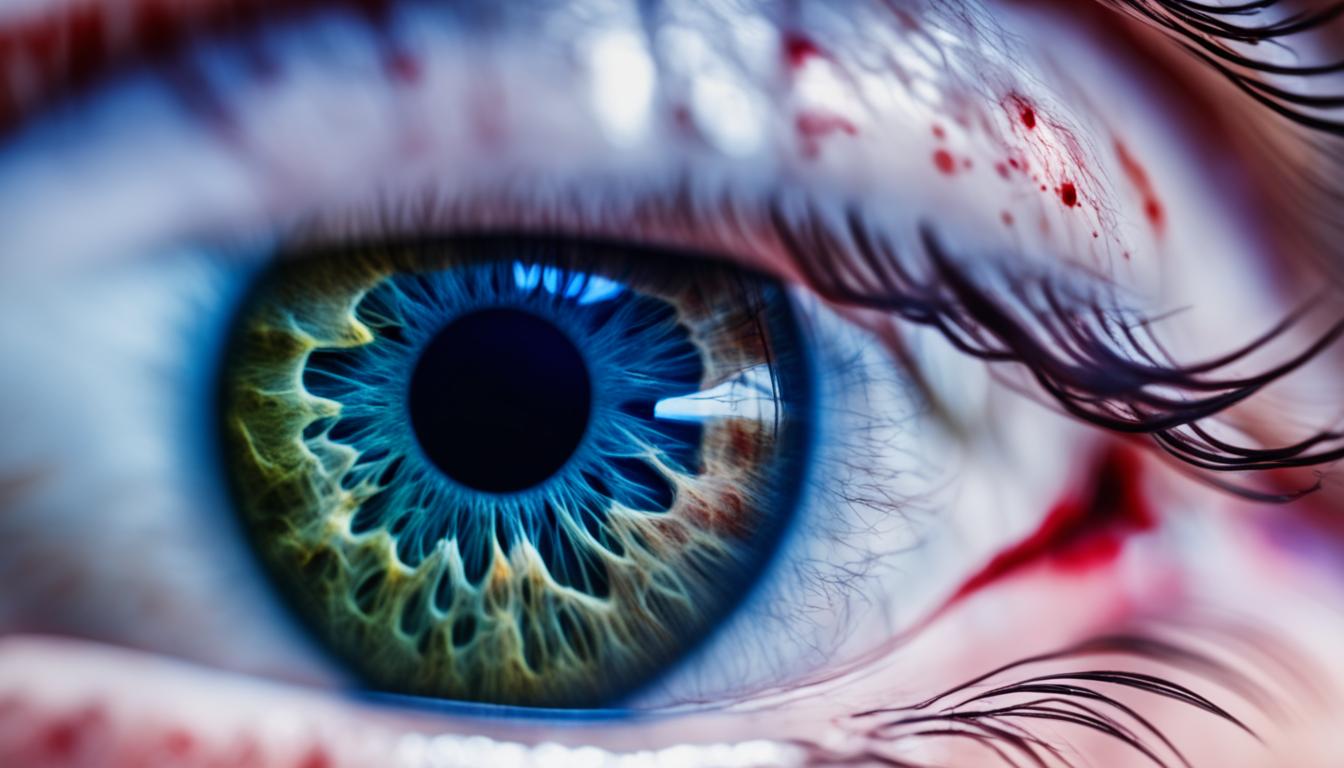Wet macular degeneration, known as “exudative” AMD, is a severe type of AMD. It’s not common but it’s worse than dry AMD. This disease shows abnormal blood vessel growth around the macula and retina. These vessels can leak proteins, which lead to scarring. Left untreated, it causes serious and lasting loss of vision.
About 10-15% of all AMD cases are wet AMD. The causes of wet AMD are not clear. But, it is linked to age, family history, and certain lifestyle choices like smoking and poor diet. The risk is also higher with too much UV light, high blood pressure, excess weight, and little exercise. Early diagnosis is key in preventing serious vision loss. Tests like the Amsler grid and fundus fluorescein angiography (FFA) are used to catch it early.
Key Takeaways:
- Wet macular degeneration is a severe form of AMD.
- It is characterized by the growth of abnormal blood vessels near the macula and retina.
- Without treatment, it can lead to significant vision loss.
- Risk factors include age, family history, and unhealthy habits like smoking and poor diet.
- Early diagnosis is vital to preventing vision loss.
- Tests like the Amsler grid and FFA are helpful in spotting wet AMD.
Symptoms and Diagnosis of Wet Macular Degeneration
Wet macular degeneration (AMD) is a critical eye disease. Early detection and fast treatment are vital to keep sight loss at bay. Knowing the symptoms of wet AMD and getting a correct diagnosis can make a big difference in how it’s controlled.
Symptoms of Wet AMD
It’s key to catch the symptoms of wet AMD early. It might not show clear signs at first, but it does have symptoms to look for:
- Straight lines appearing wavy
- Blank spots in the vision
- Difficulty with vision in low lighting
- Blurry central vision
Noticing these symptoms or any vision changes means you should see a doctor right away. Spotting it early can mean better treatment outcomes.
Diagnosing Wet AMD
Diagnosing wet AMD takes a thorough eye exam by a specialist. They’ll check your eye’s inside for signs of the disease, which includes:
- Fluid buildup in the macula
- Waste deposits around the macula
- Evidence of hemorrhaging
To make sure of the diagnosis, tests like the Amsler grid or fundus fluorescein angiography (FFA) might be needed. These tests give a clearer view of the disease’s stage. They also highlight the best treatment plan.
Finding wet AMD early is key to keeping good vision and stopping more sight loss. By getting checked by a doctor and doing the right tests, you can protect your vision.
Treatment Options for Wet Macular Degeneration
Currently, there’s no cure for wet AMD. But, we have several treatments to manage it and lower the risk of vision loss. These treatments, like drugs and therapies, are promising.
Many patients benefit from drugs that stop the growth of new blood vessels in the eye. By doing so, these drugs protect the macula and the retina. This helps keep the patient’s vision strong over time.
Scientists are also looking at gene therapy as a possible treatment. It aims to fix the eye’s genetic problems, which cause wet AMD. While gene therapy is still being studied, it could be a great option for long-term care in the future.
Stem cell therapy is another exciting area for treating wet AMD. This treatment uses stem cells to replace damaged cells in the eye. Such an approach holds promise for vision restoration in people with wet AMD.
Today, clinical trials on stem cell therapy are happening. These trials are going well, but more research is necessary to know if it’s fully safe and effective. Also, one must avoid unapproved and risky stem cell treatments that could lead to blindness.
When choosing a treatment, it’s critical to work with trusted medical professionals. They can help find the best option for your specific needs in dealing with wet AMD.
Table: Comparison of Treatment Options for Wet AMD
| Treatment Option | Method | Potential Benefits | Risks/Considerations |
|---|---|---|---|
| Macular degeneration treatment drugs | Medication (injections) | – Blocks abnormal blood vessel growth – Prevents further damage to the macula – Reduces the risk of vision loss |
– Side effects from injections – Ongoing treatment required – Costly |
| Gene therapy | Introduction of genetic material into the affected cells | – Potential restoration of normal eye function – Long-term management of wet AMD |
– Experimental stage – Further research needed – Costs and accessibility |
| Stem cell therapy | Replacement of dead or damaged cells with stem cells | – Regeneration and repair of affected areas – Potential restoration of vision – Promising results shown in clinical trials |
– Ongoing research and refinement – Safety and effectiveness still being evaluated – Beware of unlicensed clinics |
Staying up-to-date with advances in wet AMD treatments is crucial. This ensures you and your doctor can choose the best care. By actively seeking treatment and care, people with wet AMD can protect their vision and enjoy a better life quality.
Conclusion
Wet macular degeneration is a big deal when it comes to your eyes. It’s crucial to know the signs and risks. This can help catch it early and keep your vision strong.
Unfortunately, there’s no cure for wet AMD yet. But, treatments like medicines and stem cells are making progress. Remember, always talk to your doctor before trying any new treatments.
Learning about macular degeneration is key to protecting your eyes. Regular eye checks and staying on top of your health are your best defenders. They help keep your eyesight as clear as possible.

